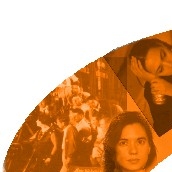


| Course M, 2:30-5:20 W, 2:30-4:20 Thomson 125 |
| Instructor K. Gillis-Bridges Padelford A305 543-4892 MW, 1:00-2:20 |
| Page last updated 7/11/02 |

Sample Essay
Constructing And Deconstructing Historical Truth
In The Watermelon Woman Cheryl Dunye makes two important statements about history. Her first point is that historical representations are always problematic due to subjective nature of historical “facts." Her second point is the logical outcome of the first: that sometimes made-up history is just as legitimate as the official “facts-based” history. Kimberly Pierce’s Boys Don’t Cry, a more mainstream film dealing with real life events helps to illustrate Cheryl Dunye’s points.
The Watermelon Woman is about Cheryl’s quest for personal history. Cheryl wants a role-model, some historical reference point to draw her strength from, to learn from. She needs a reflection of herself in the past--someone whose experience mirrors many of Cheryl’s personal concerns such as her anxiety about interracial relationships, her desire to work in a predominantly white male industry, and her relationship with her communities. Since she can’t find this someone, she makes her up. But even though Cheryl’s new-found icon Fae Richards is fictional, in the process of discovering of Fae Cheryl learns that history is very interpretive. Over and over again Dunye points out that people remember only what they choose to remember, preserve only what they want to preserve, see only what they desire to see. In the scene where Cheryl visits the Center For Lesbian Culture and Technology we see how easily parts of history can be edited out (literally, with scissors) and compartmentalized (again literally, into boxes) to suite certain people‘s idea of what it should be. In case of Martha and Fae’s relationship, history is altered simply because Martha’s sister and late Fae’s lover refuse to acknowledge it. Sometimes, as with CLIT and the black films trivia collector, this process of reinventing (through exclusion) of history is not even ill-natured. CLIT volunteers simply assume that people interested in lesbian history would only be interested in one race or another but never both. The black films collector, on the other hand, doesn’t have any information on Fae or Martha because “women are not [his] specialty." Here again Dunye suggests that history is connected to the historian’s own perspective and identity--this black gay male doesn’t want to know anything about women thus his version of history is all about men.
Boys Don’t Cry is a proof of Cheryl Dunye’s theory about history. The movie takes place in a “real” world among “real” people. Historical events rematerialize onscreen. However, according to many critics, this well-meant movie doesn’t pay justice to the people portrayed in it. Furthermore, Boys Don’t Cry creates its own version of history but tries to pass it as truth, which can be seen as immoral.
The director Kimberly Pierce can’t be blamed for neglecting facts. She has done extensive research on Brandon Teena, his friends and murderers. Yet it’s impossible to tell everything about a person in one movie especially considering that there were various accounts of his life told from different perspectives. To create an accessible narrative Pierce had to pick and choose people and events in his life. Then she had to focus on one or two aspects of his experience--thus a love-story formula with Brandon introduced to us as a boy.
Brandon’s transgender identity being disputed in real life, Pierce had to make choices or rather pick a side in the debate on the nature of transgender identity. While the transgender community wants to see Brandon as transgender--a boy trapped in a girl’s body, many non-transgender people see transgender experience as a form of denial of their homosexuality and a personality disorder resulting from such denial. A good example of this conflict is the controversy resulting from lesbian columnist Norah Vincent’s assertion (in The Advocate 6/20/02) that transgender people help to reinforce gender stereotypes and that instead of “mutilating their bodies” they should live androgynously. Coupled with claims that Brandon used to identify as a lesbian before being subjected to “conversion therapy,” this debate poses a problem for anyone trying to access Brandon’s “sexual-identity crisis.”
Not surprisingly, according to many critics, Pierce (who is a lesbian herself) fails to make a transgender movie. The love scenes between Brandon and Lana end up being lesbian scenes. According to the real-life Lana, neither she nor Brandon is a lesbian. Furthermore, as Lisa Henderson notes in “The Class Character of Boys Don’t Cry,” Pierce creates a rather stereotypical “white trash” world to convey a surreal atmosphere. This wouldn’t seem as problematic if Pierce didn’t completely exclude one of the real-life friends of Brandon, Phillip DeVine, as a result. The editing of history resembles The Watermelon Woman scene with CLIT. Here Pierce sacrifices DeVine, who was murdered along with Brandon. There two possible explanations, both problematic, of why Pierce does it. One is that including DeVine would weaken the emotional impact of the stereotypically white-trash landscape of Nebraska. The other explanation is that perhaps, if Nebraska is as “white trash” as Pierce wants to portray it, DeVine’s race played some role in his death. Whether or not the latter statement is true, Pierce chooses to simplify the story (now her story not Brandon’s) in order to focus on gender issues. Clearly Pierce sees DeVine as compromising to her film. His presence would undermine her intentions and complicate her invented world with racial context. Thus Pierce would fit perfectly with some of the characters of The Watermelon Woman who want to claim history all for themselves, leaving no room to explore multiple intersecting “truths” of identity, community and oppression.
Watching a film like Boys Don’t Cry helps to inform our understanding of The Watermelon Woman. Unintentionally, Pierce proves Dunye to be right: it is impossible to have a truly objective historical film. Traditional narrative structure works only when it’s well focused and clear--either a summary of what happened or a small fragment of it. However, the creation of such narrative is done at the expense of multiple perspectives and “facts” that come with those different perspectives.
The power of accessible narrative shouldn’t be underestimated. Boys Don’t Cry may have caused a lot of controversy among cultural critics but it also drew attention to transgender experience and hate crimes. The film has also created a very unlikely screen hero. The Watermelon Woman is a more intelligent film but it is also more elitist and exclusive. Its very important message is not lost on its audience, but in some respects as a very independent (even experimental) film, The Watermelon Woman is preaching to its choir--educated and open-minded. By employing a more traditional form of narrative Boys Don’t Cry can reach and stir more people. Yet as Dunye’s film is reminding us, this accessibility to mainstream audiences comes at a price--the price being a more simplistic one-dimensional version of reality.
Copyright
2002 Wes Naumenko
Essay may not be reproduced in any form without
the express permission of the author.
Essay may not be reproduced in any form without
the express permission of the author.